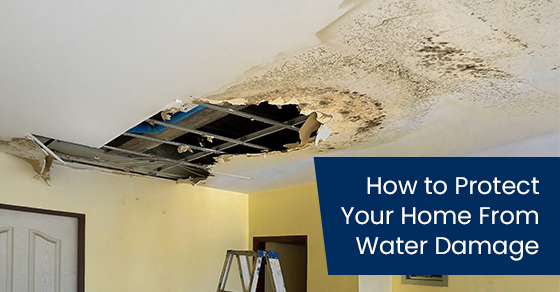 16
Jun 2023
16
Jun 2023
How to Protect Your Home from Water Damage
Water damage is every homeowner’s nightmare. Even minor leaks and humidity can lead to rapid mould and mildew growth, whereas floods can destroy priceless possessions and cause thousands of dollars in damage. Consequently, it’s imperative to protect your home from water damage.
By following the steps outlined in this article, you are taking steps to keep your home and belongings safe.
1. Regularly check appliances for leaks
Appliances like your refrigerator, water heater, AC unit, and dishwasher are common sources of leaks. In particular, the hoses that connect these appliances to your home’s plumbing system. Over time, leaks can develop as these hoses become loose and/or worn.
Consequently, you must regularly inspect your appliances for signs of wear and tear. Replace any cracked, bulging, discoloured, or leaking hoses immediately. Additionally, ensure you fasten all the connections securely.
2. Place floor pans underneath your appliances
Installing floor pans underneath appliances can prevent damage from slow, undetected leaks.
Although they won’t help during a flood, they can help mitigate water damage from smaller leaks. Consider adding floor pans in addition to your regular appliance maintenance.
3. Keep drains free of clogs and debris
When your drains are blocked, it inhibits the flow of wastewater away from your home and into the sewage system. This backed-up wastewater can seep into your cabinets, walls, and floors. Gross!
Plus, you will be forced to deal with the resulting water damage.
Fortunately, this is relatively easy to avoid. Avoid putting fibrous and starchy foods down the sink, along with hair, grease, and oil. You can also schedule regular drain maintenance with Brothers Plumbing in Toronto.
4. Inspect the caulking around your home
Caulking is responsible for keeping moisture out. However, it can only do that if it’s in good repair. Missing or cracked caulking around windows, doors, showers, and tubs frequently results in water damage.
If you see signs of mould spots, crumby drywall or plaster, bubbled paint, or termites, you can have water leakage.
Caulk is very inexpensive, so this is an easy fix to DIY.
5. Clean gutters, downspouts, and eavestroughs
Clogged gutters, downspouts, and eavestroughs cannot do their job. Instead of directing water away from your home, water sits behind the blockages. Standing water can seep into your roof or foundation, resulting in costly water damage.
As a result, clean your gutters, downspouts, and eavestroughs of leaves and debris. In winter, be mindful of ice dams that can also block water flow.
6. Know where to find the water shut-off valves
Every homeowner should know where to find their home’s water shut-off valves.
After all, every second matters after a pipe has burst. While you search for the shut-off valve, catastrophic water damage can unleash upon your home and possessions. The quicker you can shut off the flow of water, the better.
Your home has various water shut-off valves. There is the whole house water shut-off valve, the hot water heater shut-off valve, the shut-off valve for toilets and sinks, and the valves leading to the dishwasher and laundry machine.
7. Shut off the water main while you’re away
If you’re leaving for home for an extended period, shut off the water main in your absence.
This simple tip can prevent unspeakable water damage. Even a small and otherwise minor leak can cause immense damage if left undetected for days or weeks in an empathy house.
8. Maintain your sump pump
A working sump pump can save your home from a flood. When it detects water, the sump pump turns on automatically and begins to pump water out of your home. You should test your sump pump at least once a year and regularly inspect it for wear and tear or damage.
9. Keep an eye on your water bill
A mysteriously rising water bill can be the first sign that something has gone wrong somewhere within your home’s plumbing system. Instead of blindly paying your water bill, keep track of the amount and get familiar with how much it should cost each month.
If usage jumps without an obvious explanation, you may have a water leak on your hands. It might be from something as benign as a dripping faucet. However, it could also be from a broken or leaking pipe.
10. Install leak detectors
Investing in leak detectors is a great way to protect your home from water damage. These electronic devices detect rising water and set off an alarm when triggered.
They can be installed in your basement, attic, or under the sink. You can also place them near water pipes, AC units, washing machines, bathrooms, and hot water heaters.
11. Get a pressure release valve
A pressure release valve helps prevent pipes from bursting. If the pressure within the system gets too high, a valve can control or limit the pressure, bringing it down to a safe level. Frozen pipes are one possible cause for heightened pressure without your home’s water system.
12. Install a water flow monitoring system
A water flow monitoring system is another way to prevent water damage. This system detects unusual water flow and automatically stops the flow of water. Additionally, it can also improve water efficiency.
Basement waterproofing in Toronto
Basements are often damp and moisture ridden. They can devastatingly affect your home. Excessive humidity and moisture rots wood, causes cracks in concrete, and corrode metal. Mould and mildew can develop. Insects and pests are attracted. It’s a huge problem- but it is preventable.
Brothers Plumbing offers professional basement waterproofing in Toronto. Waterproofing helps to prevent water and structural damage from impacting your home. Your walls and floors will be drier, and it protects your foundation.
Thanks to basement waterproofing from Brothers Plumbing, your property is protected from water damage. Contact our team today to schedule a consultation.
For basement waterproofing in Toronto, call Brothers Plumbing at 800-741-8471 or contact us here.
